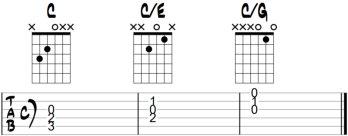
home \ courses \ music theory III \ page 1
What is a chord?
A chord is when three or more different root tones are connected (played together, or clearly grouped).
Different "root" tones means different letters. So:
- C-C-D is not a chord
- C-E-C' is not a chord
- But C-E-G is a chord
- And G-B-D-Ab-Bb is a chord
The different root notes make the chord. This has some implications that are important to know for guitarists:
- The order in which the tones appear does not change the name of the chord. C-E-G is the same as E-G-C.
- Tones can be played doubled above the octace: C-E-G is the same chord as C-E-G-C'-G'

Four different C major chords. All chords have the tones C,E and G, in different order:
- first: C-E-G-C'-E'
- second: C-G-C'-E'-G'
- third: C-E-G-C'-E'-C''
- fourth: C-G-C'-E'-G'-C''
On guitar, you can play all the tones of the chord at the same time, one after the other, or any creative combination of the two:

All A-minor chords, played in a different way. It's a chord when the tones somehow belong together.
Playing the tones of a chord one after the other is also called playing a "broken chord". When the chord tones are played in sequence from low to hight or visa versa, it's called an "arpegio".
A note about notation
Note the notation of A-minorabove: "minor" is abbreviated to "m". Sometimes a dash (-) is used: A-.
When a chord is major, there is no abbreviation. So C = C major, while Cm or C- = C minor.
Sometimes you'll see a capital M for major, like CM, and a small m for minor. Luckilly that is not common,... it's confusing!
However, later we'll look at chords with four tones. In that case it is okey (and desirable) to use a capital M (there is a difference between C7, CM7 and Cm7, more on that later in this course.)
Bass tones and ground tones
The bass tone of a chord is the lowest tone. The ground tone is the tone that gives the name to the chord. These two do not have to be the same.
Let's look at the C major chord. The tones in the C chord are:
C - E - G
If you playt these tones in a different order, it is still a C chord. The root tone remains C, the bass tone changes:
- C-E-G: root tone = C, bass tone = C
- E-G-C: root tone = C, bass tone = E
- G-C-E: root tone = C, bass tone = G
C-E-G is called the "root position"
E-G-C is called the "first inversion"
G-C-E is called the "second inversion"
Let's listen to these inversions.

root position, first inversion and second inversion of the C major chord.
<<< Previous page | Next page >>>